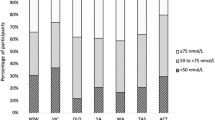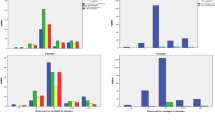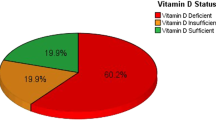Abstract
Background/Objectives:
The objectives of our study were to determine possible factors associated with low vitamin D levels in medical students.
Subjects/Methods:
A cross-sectional study was performed among 255 first- to fifth-year male undergraduate medical students of one of the major universities in Saudi Arabia. Serum 25-hydroxyvitamin D (25(OH)D) levels were measured using electrochemiluminiscence. Multiple logistic regression analysis was performed.
Results:
Majority of Saudi medical students (75.2%) had 25(OH)D levels <30 nmol/l, defined as risk for deficiency by the Institute of Medicine. Multivariate analysis showed that the odds of having 25(OH)D serum levels of ⩾30 nmol/l were seven times higher both in students who took vitamin D (odds ratio (OR)=7.2, 95% confidence interval (CI)=1.8–29.9, P=0.006) or multivitamin supplements (OR=6.9, 95% CI=1.7–27.3, P=0.006) within 1 year. Students with a history of vitamin D testing >1 year before the study or moderate/vigorous physical activity (PA) had 4.4 (OR=4.4, 95% CI=1.7–11.4, P=0.003) and 2.7-fold (OR=2.7, 95% CI=1.3–5.3, P=0.006) higher odds of having 25(OH)D levels ⩾30 nmol/l, respectively. There was no significant association between 25(OH)D serum levels and average time spent outdoors per day (P=0.369) and type of clothing (long-sleeved vs short-sleeved; P=0.800).
Conclusions:
Vitamin D deficiency was highly prevalent in Saudi medical students. Modifiable factors such as vitamin D intake and PA could be targeted for intervention. Further studies with standardized laboratory measurements of 25(OH)D are needed to explore the role of vitamin D testing in behavioral change, which may lead to increased serum 25(OH)D levels.
This is a preview of subscription content, access via your institution
Access options
Subscribe to this journal
Receive 12 print issues and online access
$259.00 per year
only $21.58 per issue
Buy this article
- Purchase on Springer Link
- Instant access to full article PDF
Prices may be subject to local taxes which are calculated during checkout
Similar content being viewed by others
References
Norman AW . From vitamin D to hormone D: fundamentals of the vitamin D endocrine system essential for good health. Am J Clin Nutr 2008; 88: 491S–499S.
Andersen R, Brot C, Jakobsen J, Mejborn H, Molgaard C, Skovgaard LT et al. Seasonal changes in vitamin D status among Danish adolescent girls and elderly women: the influence of sun exposure and vitamin D intake. Eur J Clin Nutr 2013; 67: 270–274.
Palomer X, Gonzalez-Clemente JM, Blanco-Vaca F, Mauricio D . Role of vitamin D in the pathogenesis of type 2 diabetes mellitus. Diabetes Obes Metab 2008; 10: 185–197.
Takiishi T, Gysemans C, Bouillon R, Mathieu C . Vitamin D and diabetes. Endocrinol Metab Clin North Am 2010; 39: 419–446. table of contents.
Kamen DL, Tangpricha V . Vitamin D and molecular actions on the immune system: modulation of innate and autoimmunity. J Mol Med 2010; 88: 441–450.
Prietl B, Treiber G, Pieber TR, Amrein K . Vitamin D and immune function. Nutrients 2013; 5: 2502–2521.
Grossmann RE, Zughaier SM, Liu S, Lyles RH, Tangpricha V . Impact of vitamin D supplementation on markers of inflammation in adults with cystic fibrosis hospitalized for a pulmonary exacerbation. Eur J Clin Nutr 2012; 66: 1072–1074.
Rafraf M, Hasanabad SK, Jafarabadi MA . Vitamin D status and its relationship with metabolic syndrome risk factors among adolescent girls in Boukan, Iran. Public Health Nutr 2013; 17: 803–809.
Oliveira RM, Novaes JF, Azeredo LM, Candido AP, Leite IC . Association of vitamin D insufficiency with adiposity and metabolic disorders in Brazilian adolescents. Public Health Nutr 2013; 17: 787–794.
Artaza JN, Mehrotra R, Norris KC . Vitamin D and the cardiovascular system. Clin J Am Soc Nephrol 2009; 4: 1515–1522.
Gouni-Berthold I, Krone W, Berthold HK . Vitamin D and cardiovascular disease. Curr Vasc Pharmacol 2009; 7: 414–422.
Williams S, Malatesta K, Norris K . Vitamin D and chronic kidney disease. Ethn Dis 2009; 19: 8–11.
Zheng Y, Zhu J, Zhou M, Cui L, Yao W, Liu Y . Meta-analysis of long-term vitamin D supplementation on overall mortality. PLoS One 2013; 8: e82109.
Toxqui L, Blanco-Rojo R, Wright I, Perez-Granados AM, Vaquero MP . Changes in blood pressure and lipid levels in young women consuming a vitamin D-fortified skimmed milk: a randomised controlled trial. Nutrients 2013; 5: 4966–4977.
Smit E, Crespo CJ, Michael Y, Ramirez-Marrero FA, Brodowicz GR, Bartlett S et al. The effect of vitamin D and frailty on mortality among non-institutionalized US older adults. Eur J Clin Nutr 2012; 66: 1024–1028.
Holick MF, Binkley NC, Bischoff-Ferrari HA, Gordon CM, Hanley DA, Heaney RP et al. Evaluation, treatment, and prevention of vitamin D deficiency: an Endocrine Society clinical practice guideline. J Clin Endocrinol Metab 2011; 96: 1911–1930.
Ross AC . The 2011 report on dietary reference intakes for calcium and vitamin D. Public Health Nutr 2011; 14: 938–939.
Mithal A, Wahl DA, Bonjour JP, Burckhardt P, Dawson-Hughes B, Eisman JA et al. Global vitamin D status and determinants of hypovitaminosis D. Osteoporos Int 2009; 20: 1807–1820.
Forrest KY, Stuhldreher WL . Prevalence and correlates of vitamin D deficiency in US adults. Nutr Res 2011; 31: 48–54.
Daly RM, Gagnon C, Lu ZX, Magliano DJ, Dunstan DW, Sikaris KA et al. Prevalence of vitamin D deficiency and its determinants in Australian adults aged 25 years and older: a national, population-based study. Clin Endocrinol 2012; 77: 26–35.
Pérez-López FR, Brincat M, Erel CT, Tremollieres F, Gambacciani M, Lambrinoudaki I et al. EMAS position statement: vitamin D and postmenopausal health. Maturitas 2012; 71: 83–88.
Bassil D, Rahme M, Hoteit M, Fuleihan Gel H . Hypovitaminosis D in the Middle East and North Africa: Prevalence, risk factors and impact on outcomes. Dermatoendocrinol 2013; 5: 274–298.
Elshafie DE, Al-Khashan HI, Mishriky AM . Comparison of vitamin D deficiency in Saudi married couples. Eur J Clin Nutr 2012; 66: 742–745.
Kanan RM, Al Saleh YM, Fakhoury HM, Adham M, Aljaser S, Tamimi W . Year-round vitamin D deficiency among Saudi female out-patients. Public Health Nutr 2013; 16: 544–548.
Ardawi MS, Sibiany AM, Bakhsh TM, Qari MH, Maimani AA . High prevalence of vitamin D deficiency among healthy Saudi Arabian men: relationship to bone mineral density, parathyroid hormone, bone turnover markers, and lifestyle factors. Osteoporos Int 2012; 23: 675–686.
Al-Ghamdi MA, Lanham-New SA, Kahn JA . Differences in vitamin D status and calcium metabolism in Saudi Arabian boys and girls aged 6 to 18 years: effects of age, gender, extent of veiling and physical activity with concomitant implications for bone health. Public Health Nutr 2012; 15: 1845–1853.
Rodjer L, Jonsdottir IH, Rosengren A, Bjorck L, Grimby G, Thelle DS et al. Self-reported leisure time physical activity: a useful assessment tool in everyday health care. BMC Public Health 2012; 12: 693.
Ainsworth BE, Haskell WL, Herrmann SD, Meckes N, Bassett Jr DR, Tudor-Locke C et al. 2011 Compendium of Physical Activities: a second update of codes and MET values. Med Sci Sports Exerc 2011; 43: 1575–1581.
Alshahrani FM, Almalki MH, Aljohani N, Alzahrani A, Alsaleh Y, Holick MF . Vitamin D: light side and best time of sunshine in Riyadh, Saudi Arabia. Dermatoendocrinol 2013; 5: 177–180.
Sadat-Ali M, Al Elq A, Al-Farhan M, Sadat NA . Fortification with vitamin D: comparative study in the Saudi Arabian and US markets. J Family Community Med 2013; 20: 49–52.
Vitamin D, Fact Sheet for Health Professionals National Institutes of Health 2011.
Al-Elq AH . The status of vitamin D in medical students in the preclerkship years of a Saudi medical school. J Family Community Med 2012; 19: 100–104.
Grant WB . Overweight/obesity and vitamin D deficiency contribute to the global burden of low back pain. Ann Rheum Dis 2014; 73: e48.
Moran JM, Lopez-Arza LG, Lavado-Garcia JM, Pedrera-Canal M, Rey-Sanchez P, Rodriguez-Velasco FJ et al. Hormonal relationships to bone mass in elderly spanish men as influenced by dietary calcium and vitamin D. Nutrients 2013; 5: 4924–4937.
van den Heuvel EGHM, van Schoor N, de Jongh RT, Visser M, Lips P . Cross-sectional study on different characteristics of physical activity as determinants of vitamin D status; inadequate in half of the population. Eur J Clin Nutr 2013; 67: 360–365.
Dong Y, Pollock N, Stallmann-Jorgensen IS, Gutin B, Lan L, Chen TC et al. Low 25-hydroxyvitamin D levels in adolescents: race, season, adiposity, physical activity, and fitness. Pediatrics 2010; 125: 1104–1111.
Al-Othman A, Al-Musharaf S, Al-Daghri NM, Krishnaswamy S, Yusuf DS, Alkharfy KM et al. Effect of physical activity and sun exposure on vitamin D status of Saudi children and adolescents. BMC Pediatr 2012; 12: 92.
Saliba W, Rennert HS, Kershenbaum A, Rennert G . Serum 25(OH)D concentrations in sunny Israel. Osteoporos Int 2012; 23: 687–694.
Freeman J, Wilson K . Vitamin D, progress toward standardization. Clin Lab News 2013; 39: 8–10.
Acknowledgements
This work was supported by College of Medicine Research Center, Deanship of Scientific Research, King Saud University, Riyadh, Kingdom of Saudi Arabia.
Author information
Authors and Affiliations
Corresponding author
Ethics declarations
Competing interests
The authors declare no conflict of interest.
Rights and permissions
About this article
Cite this article
BinSaeed, A., Torchyan, A., AlOmair, B. et al. Determinants of vitamin D deficiency among undergraduate medical students in Saudi Arabia. Eur J Clin Nutr 69, 1151–1155 (2015). https://doi.org/10.1038/ejcn.2014.286
Received:
Revised:
Accepted:
Published:
Issue Date:
DOI: https://doi.org/10.1038/ejcn.2014.286



